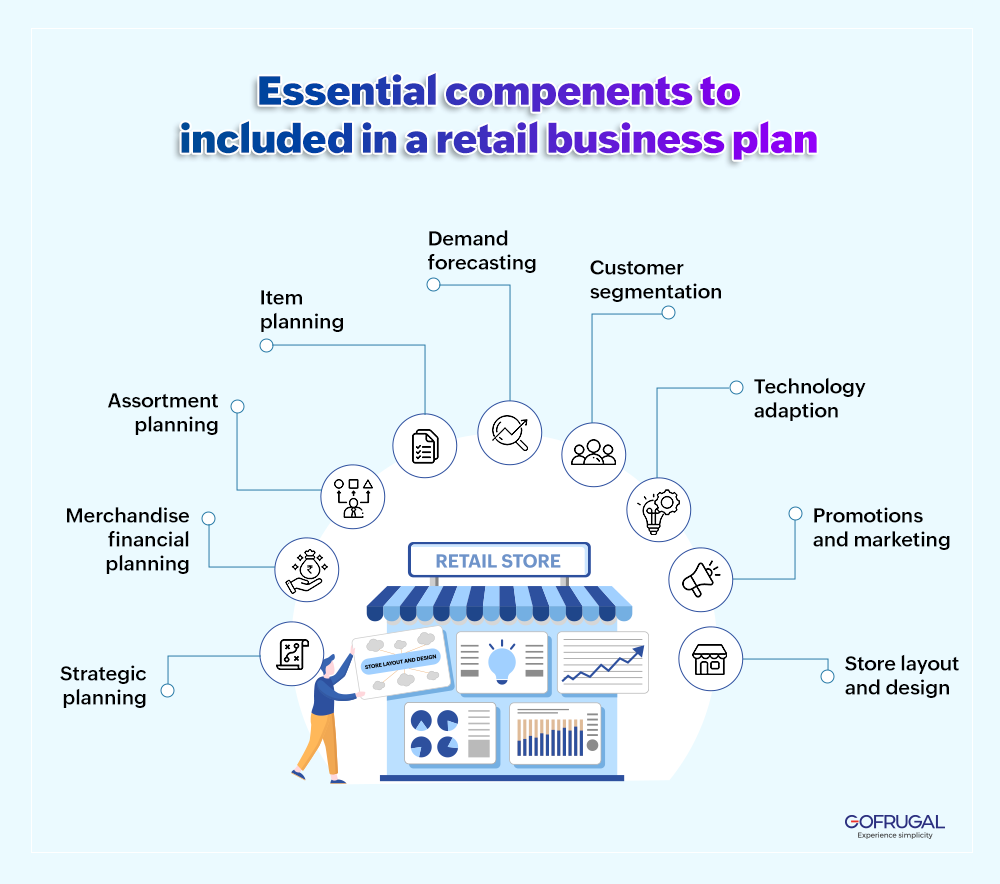Ever thought about running your own store? Maybe you've discussed with friends how much a store could make each month. Turning this idea into reality is not for everyone, but if you're one of the brave ones stepping into the retail world, you're in the right spot. This guide walks you through the steps of starting a retail business by providing a clear picture of how to make a great retail business plan.
Contents
- What exactly is a retail business plan?
- Why should you create a retail business plan?
- Essential components to include in a retail business plan
- How to make a retail business plan
- Retail business plan template
- Challenges in retail planning
- How Gofrugal helps your retail planning
What exactly is a retail business plan?
At its core, a retail business plan is a strategic document that outlines the goals, objectives, and methods a retail store will employ to achieve success. It's not just a document for securing funding; it's a roadmap that provides direction and clarity for both the business owner and potential investors. A well-crafted retail business plan delves into every aspect of your retail venture, offering insights into the market, competition, and your unique value proposition.
Why should you create a retail business plan?
- Clarity of vision: Define your business concept, target market, and offerings clearly for a precise understanding of your vision.
- Financial blueprint: Craft a dynamic retail business plan to attract capital investment. Detail strategies for securing loans and investors, and leveraging existing resources. Secure loans with a strong credit profile and clear goals. Attract investors by highlighting your business's unique value proposition and financial stability.
- Risk mitigation: Conduct a thorough analysis of your plan to identify potential challenges. Develop strategies for risk mitigation to ensure resilience in the face of uncertainties.
- Strategic decision-making: Use your well-defined plan as a guide for maintaining focus, especially during challenging times. It serves as a blueprint for strategic decision-making, navigating uncertainties, and steering the business toward success.
Essential components to include in a retail business plan
Strategic planning
Strategic planning forms the bedrock of a robust retail business plan. It involves developing a crystal-clear vision and mission, setting long-term goals, and being adaptable to market changes. Incorporating these elements into your business plan ensures a roadmap that guides your retail venture towards sustained success.
Merchandise financial planning (MFP)
Money matters, especially in retail. Budgeting and allocating financial resources for inventory is a critical aspect of any retail business plan. MFP involves forecasting demand, optimizing stock levels, and monitoring expenses related to merchandise. These financial considerations are pivotal components of a comprehensive business plan for a retail store.
Assortment planning
Creating a product mix that resonates with customers is an art. Assortment planning involves curating a well-balanced range of products aligned with customer preferences. Your retail business plan should emphasize the importance of analyzing sales data to refine and improve the assortment continually. This ensures your merchandise resonates with your target audience, enhancing the overall retail experience.
Item planning
Effective item planning involves managing individual product performance and lifecycle. A well-crafted business plan for a retail business should emphasize the optimization of pricing and promotions for each item. Understanding market segments and tailoring item planning accordingly ensures a dynamic and responsive approach.
Demand forecasting
Anticipating customer demand is a crucial element of any retail business plan. Utilize historical sales data and market trends for accurate forecasting, minimizing stockouts and overstock situations. Integrating demand forecasting into your plan ensures your inventory aligns with customer expectations.
Customer segmentation
Identifying and understanding different customer segments is crucial for personalized offerings. Your business plan for a retail store should emphasize tailoring product assortments, promotions, and marketing strategies for each segment, enhancing the overall customer experience.
Technology adaption
Elevate your business efficiency by choosing an all-encompassing ERP solution over multiple software applications and minimize the need for extensive integrations. Experience seamless operations, enhanced data integration, and simplified decision-making, reaping the benefits of a unified technology approach.
Promotions and marketing
Creating effective marketing campaigns and promotions is key to driving sales. Design promotions aligned with your business goals and measure their impact on sales and customer engagement. Your retail business plan should detail your promotional strategies for maximum impact.
Store layout and design
Optimizing the physical layout of your retail space is essential for a pleasant customer experience. Ensure efficient traffic flow and highlight key products, adapting store design to reflect the brand identity and values outlined in your business plan.
How to make a retail business plan
1. Executive summary
Your mission is to provide accessible and high-quality products or services to your customers, ensuring their satisfaction and convenience. For this, precisely mention your company's mission, vision, and goals. Summarize the following strategy elements.
- Target market: Identify your audience and tailor strategies to meet their unique needs.
- Products and services: Conceptualize a curated selection, from highlighting key offerings to additional products and services, each designed to elevate the customers' shopping journey.
- Financial projections: Anticipate a prosperous future by forecasting financial projections, ensuring sustained growth for your business.
- Unique selling point (USP): What sets you apart? It's your unwavering commitment to ensuring every customer interaction leaves a lasting impression.
2. Market analysis
To succeed in retail business, track industry trends to anticipate shifts in consumer behaviour, technology, and market demands. Identify your target market by examining demographics, preferences, and behaviours, guiding product and marketing decisions. Conduct a thorough competitor analysis to understand strengths, weaknesses, and market share. Evaluate market demand to align offerings with customer needs to address gaps and anticipate future demands. Adapt strategies by introducing innovative products, enhancing the customer experience, or focusing on sustainability in your retail business plan.
3. Organization and management
In your retail business plan, clearly outline your organizational and management structure. Specify whether your business is a sole proprietorship, LLC, or corporation. Introduce key team members, providing details on their roles and relevant experience in the context of your retail store. Describe the organizational hierarchy, highlighting responsibilities to give a comprehensive view of the team's functions. When writing your retail business plan, ensure this section reflects an organized and capable team, emphasizing their expertise in driving the success of your retail business.
4. Products and services
The plan should clearly describe what products and services your store will offer. Point out the special features and benefits that make your offerings stand out. Explain how these distinctive aspects cater to customer needs and preferences, setting your retail business apart from others. Additionally, share your plans for expanding your product or service lineup in the future, giving insight into the exciting developments your customers can expect.
5. Marketing and sales strategy
In your comprehensive business plan for your retail store, precisely define effective strategies to engage your target audience. Elaborate on your pricing strategy, promotional activities, and chosen distribution channels. Detail the sales process, focusing on both customer acquisition and retention. This strategic approach is fundamental to a business plan for a retail business to showcase tailored methods for attracting and retaining customers.
6. Funding request
Clearly specify the amount of funding you are seeking within your retail shop business plan. Articulate the planned allocation of funds for startup costs, working capital, and other essential expenses. Offer a transparent breakdown of your current financial situation, providing potential investors with a clear understanding of your retail business's financial needs and the anticipated return on investment.
7. Financial projections
In your retail business plan, develop detailed income statements, balance sheets, and cash flow statements. Project the financial performance of your retail store for the next three to five years. Include clear key assumptions and the basis for your projections, offering a realistic and grounded overview of your business's expected financial trajectory. Additionally, provide a sensitivity analysis to demonstrate how changes in key variables might impact your financial outlook.
8. Operations plan
Outline day-to-day operations, covering aspects such as location, facilities, equipment, and technology. Discuss your suppliers, elaborate on inventory management practices, and detail logistics processes. Specify the technology systems you will employ to enhance operational efficiency, such as point-of-sale systems and inventory tracking tools.
9. Risk analysis
Identify potential risks and challenges in your retail business plan. Develop contingency plans for risk mitigation, addressing strategies for adapting to market or industry changes. Provide a risk matrix that evaluates the likelihood and impact of each identified risk. Additionally, incorporate insurance coverage and other risk management measures to showcase a comprehensive approach to risk mitigation.
10. Review and refinement
Regularly review and update your retail business plan as your business evolves. Seek feedback from mentors, advisors, or industry experts to ensure your plan remains relevant and effective. Establish a formal review schedule and document any changes made to your plan. Consider incorporating a scenario analysis to assess the impact of different market conditions on your business, enhancing the plan's adaptability to changing circumstances.
Retail business plan template
Challenges in retail planning
Retail planning commonly encounters challenges like demand forecasting errors, inventory mismanagement, market volatility, and additional practical hurdles such as supply chain disruptions, changing consumer preferences, and technological obsolescence, posing potential disruptions to business operations.
Overlooking these challenges may result in issues like excess or insufficient inventory, customer dissatisfaction due to stockouts, financial losses, compromised supply chains, outdated technology investments, and an inability to adapt to evolving customer needs, emphasizing the need for proactive solutions.
How Gofrugal helps your retail planning
Gofrugal excels in automating and optimizing key elements of retail planning, enhancing operational efficiency. Solutions like GoSure for inventory management, The EYE for purchase management, and Exclusive CRM for customer engagements streamline processes. GoAlerts facilitates SMS and WhatsApp marketing, while POS analytics reports empower informed decision-making and trend prediction. GoBill ensures express checkout during billing, reflecting the platform's commitment to execution simplicity.
Gofrugal's strength lies in providing the right insights for strategic decision-making. From supplier management to omnichannel solutions, it caters to the diverse needs of businesses. Its commitment to giving the right insights, decision-making capabilities, execution simplicity, transaction tracking, and ease of scaling businesses positions it as a transformative force in the retail software landscape.
Ready to level up?
In essence, a well-crafted plan is an essential guide for your retail business plan. From strategic insights to overcoming challenges, this blog post has laid the groundwork to help you begin your own business journey. As you step into the retail arena, trust Gofrugal—more than software, a partner in your success story. With proven solutions and a commitment to simplicity, let Gofrugal propel your business forward.





